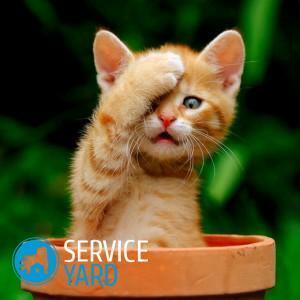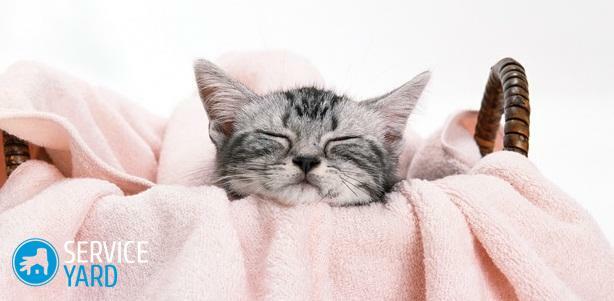
- Why do I need to wash a cat?
- When to wash the cat? From what age should you bathe a kitten?
- Basic contraindications to washing
- Than to wash a cat?
- How to wash a cat at home?
- How to dry the cat?
Pets are cats, they are considered to be the most clean, because they clean themselves up several times a day. That is why many believe that there is no need to wash fluffs regularly, but it is not. Any animal needs proper care, of which water procedures are a part. In the article we will tell you how to wash the cat so that this procedure does not become a psychological trauma for your pet and yourself.
to the contents ↑Why do I need to wash a cat?
The tendency to neatness and cleanliness in cats is inherent in nature. From an early age, they regularly lick their wool and clean it of dust, daily various contaminants. The wool and skin of all the fuzzy is protected by the lubricant that their glands produce. Such lubrication protects the skin of animals from parasites and skin diseases. Therefore, a healthy cat often should not be washed, so as not to remove the protective grease and not to spoil the hairs of the wool.
to the contents ↑When to wash the cat?
Any cat should be washed 3-4 times a year. However, if the pet is often outdoors, the interval between bathing should be a couple of months, and cleaning the legs after a walk should be regular. It is this kind of care that will help a pet always maintain his fur coat in an attractive, and most importantly, healthy state.
An unplanned catwash should be performed in the following cases:
- Presence of parasites in wool. Those animals that spend a lot of time on the street may have fleas and ticks. Without careful water procedures and special treatment in this case can not do.
- The cat got dirty and can not cope with the dirt by itself. In situations where chemical impurities are present on the cat's fur, it is necessary to start washing immediately, otherwise the animal may be poisoned.
- During a strong seasonal moult. During this period the cat, washing itself, swallows too many hairs that can gather in the stomach and create a digestive problem.
- Preparation for the exhibition. It's about pedigreed cats, who regularly take part in a variety of exhibitions. In this case, the frequency of water procedures can increase at times.
Important! If you picked up the animal on the street, then to wash the cat is necessary immediately after coming home. After water procedures, show the "found" to the veterinarian.
Important trifles:
- If you are the owner of a long-haired breed of cats, then prepare yourself for frequent water procedures, as long wool needs additional care.
- If you regularly wash the cat, this will simplify the subsequent process of combing the wool.
Important! It is necessary to remember, if all the same you doubt, whether it is necessary to wash cat .On the coat of your pet, except for dust and dirt, various microorganisms accumulate. A considerable amount of microbes is brought by the owner himself from the street on shoes or clothes. Therefore, to ensure that your pet is healthy, you must bathe him, even if he does not go outside the room.
to the table of contents ↑From what age should you bathe the kitten?
Exhibition owners are advised to begin to accustom a kitten to water procedures in a month. This will simplify the care of the pet in the future and relieve him of stress, panic fear of water noise and bathing.
But many experts consider this age too early. The optimal age is 3-5 months. During this period, a small kitten will easily bear the stress of bathing.
Important! When washing a baby, it must be remembered that small kittens are more susceptible to hypothermia than adults.
to the contents ↑Basic contraindications for washing
It is not recommended to wash the cat at a certain life period. Such contraindications include:
- Postoperative rehabilitation. First of all, consult a veterinarian and wait for the full healing of the joints.
- Any diseases. After water procedures, the health of the pet can dramatically worsen.
- Pregnancy. Especially in later terms, the cat can not be washed, since severe stress during this period is highly undesirable.
- Feeding period. It is highly undesirable to wash a nursing cat - due to stress, milk may disappear.
- The period after vaccination. From the time of vaccination to the bath should be at least 2 weeks.
- The period after the castration of the cat. Take a break between the procedure and the planned bathing for at least 10 days.
- Cold room and drafts. If the apartment is cold and there are drafts, then limit water procedures, because the low temperature of the air in the room can cause the disease of the pet. The temperature in the room in which the pet will stay after washing should be at least 22 degrees. Windows and doors during this period should be tightly closed.
- Old age. To conduct water procedures for cats and cats in old age is not recommended - because of the received stress, the heart of the animal can not stand.
Than to wash the cat?
Many owners of domestic cats neglect the use of special hair care products. Of course, there is no strict ban on normal shampoo, but it must be remembered that the acid-base balance of man and animal is different. Therefore, detergents intended for people harm the skin and coat of cats.
Important! The human pH is 3.5-4.5 units, and cats - 3-6 pH.Accordingly - applying shampoo for hair, you dry the skin of the cat. After such a washing procedure, the cat starts to itch, and dandruff appears on the coat. In addition, a number of components included in the cleanser for humans, can cause allergies in the pet.
In order not to expose your pet even more trouble, get special shampoos for wool in any pet store. They can be in different forms, so in choosing what to wash the cat, you are not limited. Prefer one of the following:
- Dry. This option is most relevant if the cat is afraid of water. Shampoos are presented in the form of powder without a pronounced smell. Powder is applied to dry hair, and after a while it is actively combed out. Dry shampoo effectively copes with everyday dirt, simplifies the process of combing. This tool can be used regularly, since it does not harm the health of the cat.
- Classical liquid. On the shelves of shops you can see shampoos of different functionality: moisturizing, antiparasitic, hypoallergenic, etc. The main advantage of liquid shampoo is the high efficiency of removing contaminants. Choose a shampoo to wash the cat, based on the type and color of the coat.
- Sprays. These drugs are practically the same as normal shampoo, but they are much more convenient to use. No need to pour detergent into the palm, rub it into the coat. In addition, after applying the product, you can notice a pronounced antistatic protection. Some products have a light and pleasant aroma. Therefore, using a spray to wash the cat, you make your pet's fur soft, shiny, attractive and fragrant. However, many cats react very nervously to the sound of the spray and this can cause additional inconvenience during water procedures.
Important! When choosing the right detergent, pay attention to the composition of the product - there should not be any aggressive ingredients in it. Recommended vegetable extracts in the shampoo, which soften the skin and eliminate unpleasant itching.
Useful advices:
- In case there is no special detergent at home, it is best to transfer the water procedure. Limit simple wiping of animal hair with a damp cloth. As an option - the services of a hairdresser. The specialist will conduct all necessary procedures at home using shampoos and conditioners for animals.
- To ensure that the pet's coat looks neat, buy extra balm. It will help to solve the problem with dull and brittle hair, restore the structure of the hairs and prevent overdrying of the skin.
How to wash the cat at home?
Before proceeding with water procedures, it is necessary to minimize the discomfort of the patient, that is, to prevent severe stress.
Preparation of a bath
To properly prepare for the bathing procedure, listen to the following recommendations:
- On the day when you plan to wash the cat, do not worry about it. If the animal behaves excitedly, it is better to postpone the procedure the next day.
- 4-5 hours before the bath, feed the cat. You can not conduct water procedures with a full stomach, as this will damage the health of the animal.
- Prepare a place to swim. To wash in a basin of a cat it is impossible, as the animal will cling to edges. It is better to prepare the bathroom:
- From the room, remove all unnecessary items: soap dishes, washcloths, bottles, bottles, brushes and other small items that can suddenly fall.
- Remove the hanging towels so that the animal does not pull them together.
- Put a rubberized mat on the bottom of the tub.
- Pour in the necessary amount of water in advance, so that it touches the belly of the patient. The water temperature should be 35-37 degrees, and the room - at least 22 degrees.

- Prepare a basin with water, which you will wash off soap foam. It is better not to use a shower, a tap or a hose for this purpose, since the noise can scare the animal.
- Open the shampoo, conditioner or balm and put them so that you can reach them without problems.
- Prepare a few towels.
Cat preparation
Cat also needs to be prepared for water procedures:
- Pet with long hair pre-comb and remove unaesthetic coils.
- If possible, purchase special plugs for cat ears so that during bathing, water and detergent do not get into the ears of the patient.
- Cut the claws with a special tool.
- Take the animal in your arms, stroke it, talk kindly, try to remove the nervous tension of the pet.
How to properly wash a cat?
So, the bathtub is dialed, you have changed into working clothes, it only remains to place the cat in the water. Carefully take the pet by the scruff so that it can not catch on your clothes and act according to the plan:
- Enter the bathroom with the pet, immediately close the door tightly so that it does not get out of the room.
- Carefully lower the cat into the water. Hold it for a few minutes to get used to the water.
- With damp movements moisten the hair. Use a free hand or a cup. Be careful not to let water enter your ears. Water on the head and face put the last.
- Gently wash the animal's body. A small amount of shampoo spread on the back. If possible, place the animal on its hind legs to soap the breast. Lather the forelimbs, tummy and tail.
- Last wash the chin and the area between the ears.
- Rinse the soap with water from the basin.
- Apply balm or conditioner. Distribute the product with massage movements throughout the hair and body.
- After all procedures, give the pet a few minutes to investigate the environment.
- Remove the remaining water, gently and gently wrung the fur with your hands.
- Wrap the animal in a towel. Use for this purpose a waffle towel, which absorbs moisture better.
How to dry the cat?
After water procedures, the pet should not walk around on his own, and in no case - go out. After bathing for the cat should be carefully monitored. Better - in a warm room without drafts spread a large rug or towel and put a cat on it. You can dry the cat with a hair dryer, but if the animal is not afraid of the sound of the device. To do this:
- Select the optimal mode( air flow should not be hot).
- Start drying from the head.
- Gradually go to the area of the chest, front legs, tummy and back.
- Lastly, dry the tail and hind legs.
- Move the hair dryer smoothly. The distance between the device and the animal should be 30-40 cm.

Useful advices:
- Do not dry the coat with a towel, as there is a risk of deteriorating the condition of the cover.
- To gradually accustom the cat to the bathroom, put a few toys first in the empty plumbing - let the animal play with them and get comfortable. Then gently add some water before playing with your favorite toys. Accustoming the pet in this way, he will understand that in the bathroom he is not threatened.
- Buy a special toy that you will use only in the bathroom, for example, a mouse on a string. Let's play the toy only in the bathroom to inspire the animal to water procedures.
- If the bath and the bathroom are combined, then during the bath, close the lid of the toilet so that the animal does not panic in the pan.
- Do not rub the hair against growth, it's best to dab the fur with a towel. If one towel is small, then use two.
- If the kitten categorically does not want to swim, then lighten up the task and put on the harness a harness with a leash. Secure the end of the leash so that the animal does not break out.
- It is most convenient to bathe an animal alone. One person holds the pet securely, and the other - thoroughly washes it.
- If you bathe the cat for preventive purposes with shampoo from fleas, then first moisten the neck area. A wet neck area will keep fleas away from the head, thereby facilitating the use of the remedy.
- Do not wash your pet's face with soap and water. Just take a damp cloth and wipe the muzzle and places near the eyes and nose. Wipe the muzzle is not necessary during bathing - you can do it later, when the animal calms down.
- At the first bath, be calm and friendly, so that the cat understands that the danger does not threaten it.
We hope that during the bathing your cat did not get stressed, and you did not get injured. If your pet categorically refuses water procedures, do not despair, but simply wipe her fur with a damp cloth. The main thing - take care of her and your health.



